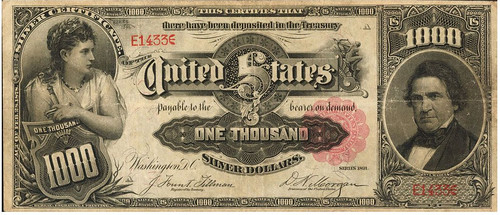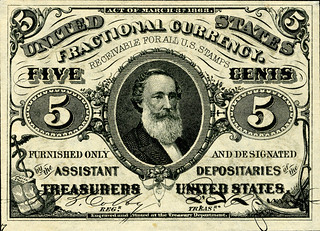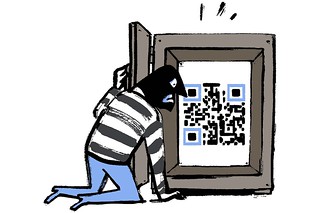
PREV ARTICLE
FULL ISSUE
LOOSE CHANGE: JANUARY 6, 2019Here are some additional items I came across in the media this week that may be of interest. -Editor The $3 Million $1,000 Bill Martin Kaplan passed along this Bloomberg article about the 1891 Marcy $1,000 bill from the Joel R. Anderson collection. Thanks. -Editor  One of those $1,000 bills ended up in the Smithsonian. Another remained in a private collection for over 80 years; its first reported sale as a collectible item, rather than a piece of currency, was in the 1970s. The rest, presumably, were lost. ("I'd bet a lot of money that another one of these notes won't turn up," Treglia says. "Things are discovered all the time, but not of this magnitude.") That single remaining note, dubbed the "Marcy Note" because it features a portrait of U.S. Senator (also secretary of war and governor of New York) William Marcy, is now up for auction with an estimate of $2 million to $3 million. To read the complete article, see: The Infamous Spencer M. Clark Portrait Atlas Obscura published a nicely done piece on the Fractional Currency note with the image of National Currency Bureau Superintendent Spencer M. Clark. -Editor
Clark, who served as Superintendent from 1862 to 1868, had no authorization from his superiors to do this. But U.S. paper bills were in flux because of the recent introduction of fractional money, and as the supervisor of the new bills, he was in a unique position to influence the design. It was the third issue of that five-cent note that caught Clark's attention. Congress had asked for the note to honor William Clark of the Lewis and Clark explorations. But allegedly, the document that reached the Treasury specified only that the new bill should honor "Clark," without clarifying which one-and Spencer M. Clark, despite surely knowing Congress's true intention, seized the opportunity to print his own face on the bill. To read the complete article, see: Article Highlights CCAC Member Robin Salmon Although Salmon, the vice president of collections and curator of sculpture at Brookgreen Gardens, represents a different constituency, she was appointed to the U.S. Mint's Citizens Coinage Advisory Committee just after NBA legend Kareem Abdul-Jabbar resigned from the 11-member body. In October, Salmon officially replaced Heidi Wastweet as the committee member specially qualified in medallic art and sculpture. To read the complete article, see: Without Hard Cash, What's Left To Steal? Another Wall Street Journal article this weekend imagines the cashless future. -Editor
In theory, there is nothing wrong with sending cash, an anachronistic entity, entirely to the sidelines. If criminals insist on pulling off old-school stick-em-ups, they're going to have to make do with stealing Slim Jims, Twinkies and Dos Equis. The 7-Eleven won't have any loot to stuff inside a pillowcase. But inevitably the Law of Unintended Effects will rear its ugly head. To read the complete article (subscription required), see: Wayne Homren, Editor The Numismatic Bibliomania Society is a non-profit organization promoting numismatic literature. See our web site at coinbooks.org. To submit items for publication in The E-Sylum, write to the Editor at this address: whomren@gmail.com To subscribe go to: https://my.binhost.com/lists/listinfo/esylum All Rights Reserved. NBS Home Page Contact the NBS webmaster 
|

